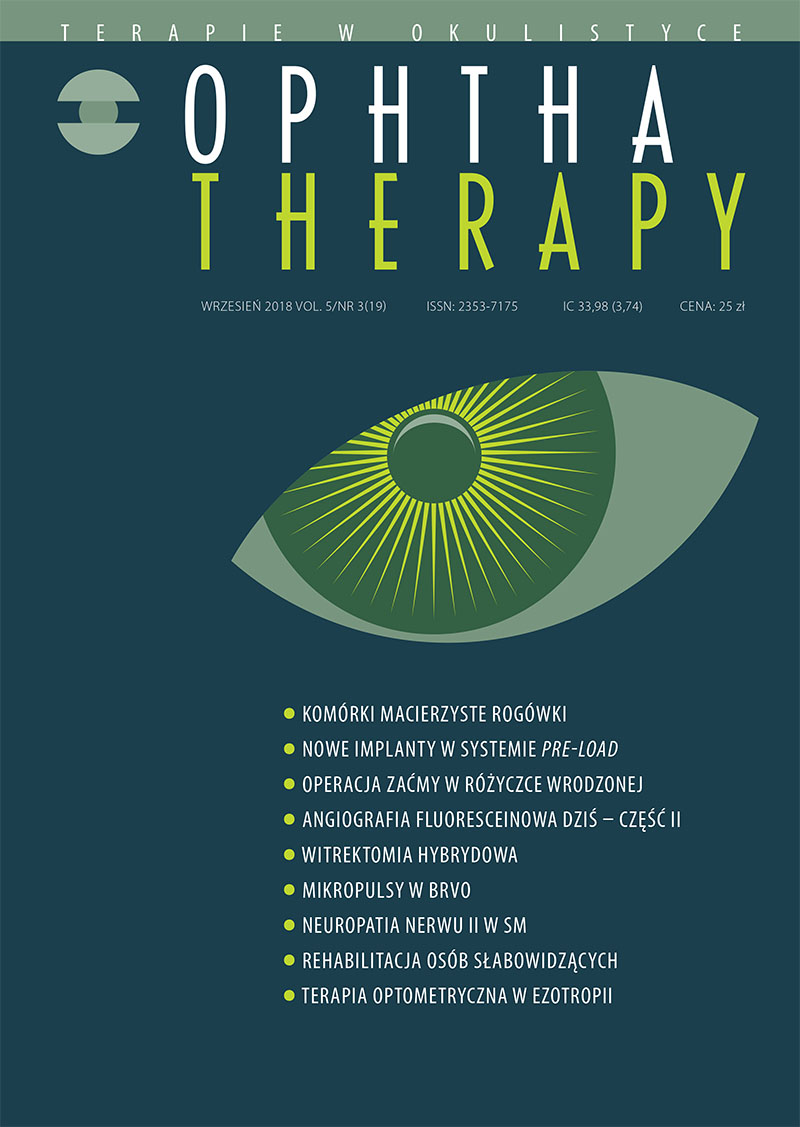Application of micropulse laser treatment in macular oedema in course of branch retinal vein occlusion
Main Article Content
Abstract
It is estimated that the number of patients who each year experience the consequences of a branch retinal vein occlusion in Poland reaches 160,000 people. The part of them has an asymptomatic course, others are affected by decreased visual acuity caused by ischemia and subsequent macular edema. In confirmed cases, the intravitreal supply of the anti-VEGF preparation is recommended. Subthreshold micropulse laser therapy is a safe alternative in the early forms of macular edema in the branch retinal vein occlusion. The best therapeutic effects were achieved in patients with a time of onset not exceeding 6 months. In 5 out of 7 treated patients, an improvement in visual quality was observed after 4–8 weeks after laser treatment. Reduction of retinal thickness was noted in 6 patients. The safety and availability of micropulse laser therapy are an incentive for its use in patients with complications after branch retinal vein occlusion.
Downloads
Article Details

This work is licensed under a Creative Commons Attribution-NonCommercial-NoDerivatives 4.0 International License.
Copyright: © Medical Education sp. z o.o. License allowing third parties to copy and redistribute the material in any medium or format and to remix, transform, and build upon the material, provided the original work is properly cited and states its license.
Address reprint requests to: Medical Education, Marcin Kuźma (marcin.kuzma@mededu.pl)
References
2. Genentech based of population-based studies, the Beaver Dam Eye Study. 2000, 2008.
3. Argon laser photocoagulation for macular edema in branch vein occlusion. The Branch Vein Occlusion Study Group. Am J Ophthalmol. 1984; 98(3): 271-82.
4. Roider J. Laser treatment of retinal diseases by subthreshold laser effects. Semin Ophthalmol. 1999; 14(1): 19-26.
5. Inagaki K, Ohkoshi K, Ohde S et al. Subthreshold Micropulse Photocoagulation for Persistent Macular Edema Secondary to Branch Retinal Vein Occlusion including Best-Corrected Visual Acuity Greater Than 20/40. J Ophthalmol. 2014, 2014: 251257.
6. Lavinsky D, Sramek C, Wang J et al. Subvisible retinal laser therapy: titration algorithm and tissue response. Retina. 2014; 34(1): 87-97.
7. Hayreh S, Zimmerman M. Branch retinal vein occlusion: natural history of visual outcome. JAMA Ophthalmol. 2014; 132(1): 13-22.
8. McIntosh RL, Rogers SL, Lim L et al. Natural History of Central Retinal Vein Occlusion: An Evidence-Based Systematic Review. Ophthalmology. 2010; 117: 1113-23.
9. Chatziralli IP, Jaulim A, Peponis VG et al. Branch retinal vein occlusion: treatment modalities: an update of the literature. Semin Ophthalmol. 2014; 29(2): 85-107.
10. Campochiaro PA, Heier JS, Feiner L et al. Ranibizumab for macular edema following branch retinal vein occlusion: six-month primary end point results of a phase III study. Ophthalmology. 2010: 117(6): 1102-12.
11. Hayreh SS, Rubenstein L, Podhajsky P. Argon laser scatter photocoagulation in treatment of branch retinal vein occlusion. A prospective clinical trial. Ophthalmologica. 1993; 206: 1-14.
12. Inagaki K, Shuo T, Katakura K et al. Sublethal Photothermal Stimulation with a Micropulse Laser Induces Heat Shock Protein Expression in ARPE-19 Cells. J Ophthalmic. 2015; 2015: 729792.
13. Scholz P, Altay L, Fauser S. A Review of Subthreshold Micropulse Laser for Treatment of Macular Disorders. Adv Ther. 2017; 34(7): 1528-55.
14. Parodi MB, Iacono P, Bandello F. Subthreshold grid laser versus intravitreal bevacizumab as second-line therapy for macular edema in branch retinal vein occlusion recurring after conventional grid laser treatment. Graefes Arch Clin Exp Ophthalmol. 2015; 253(10): 1647-51.

